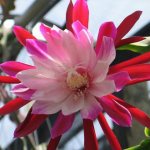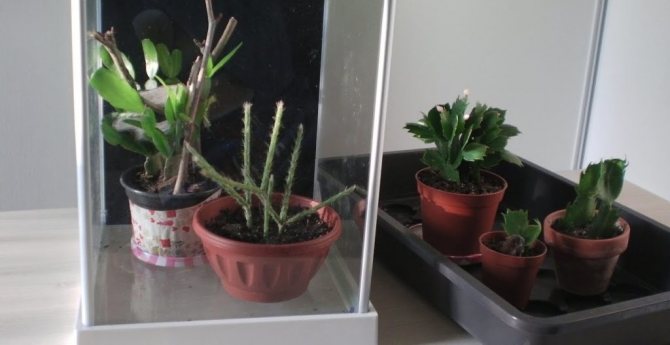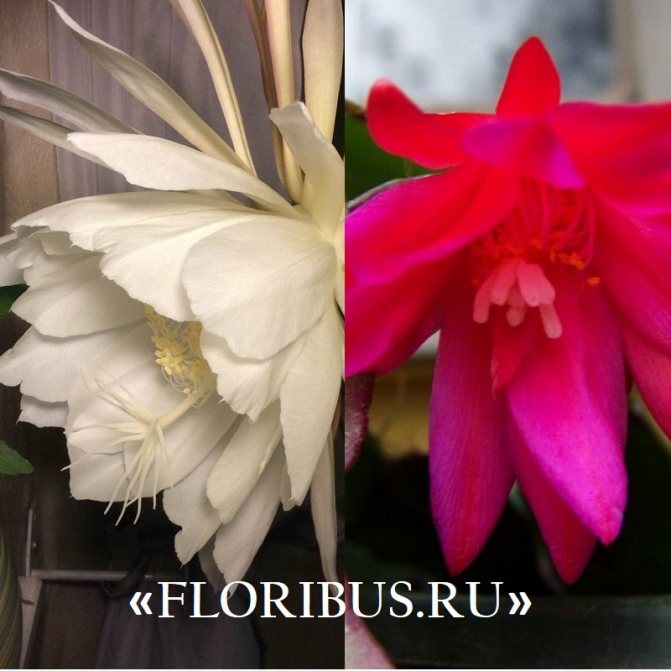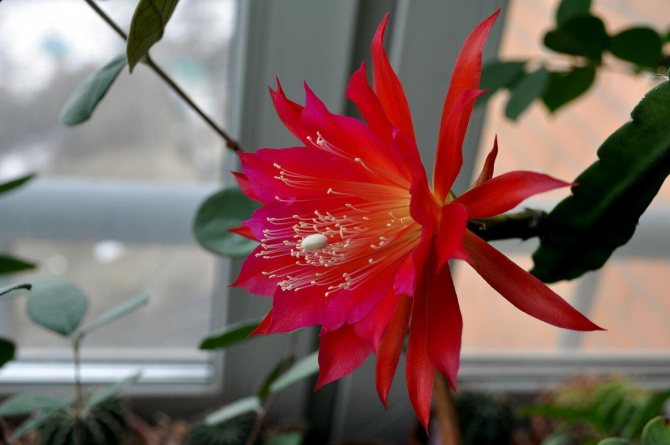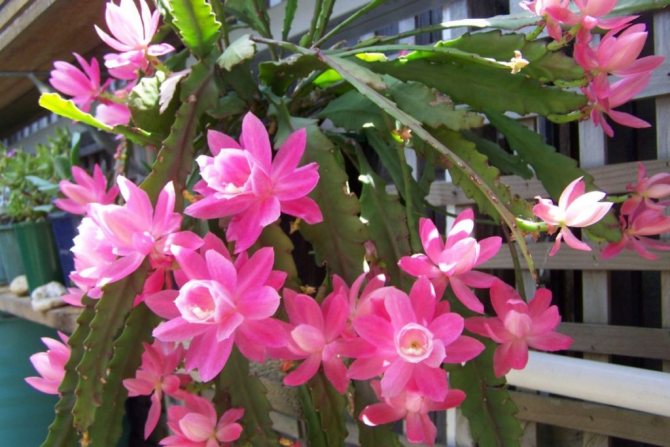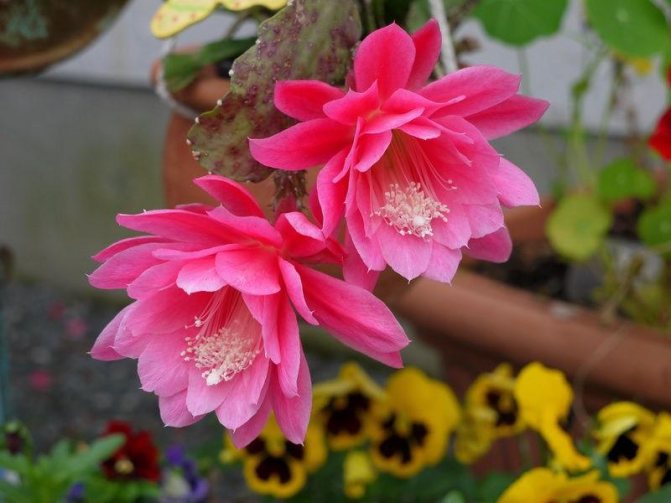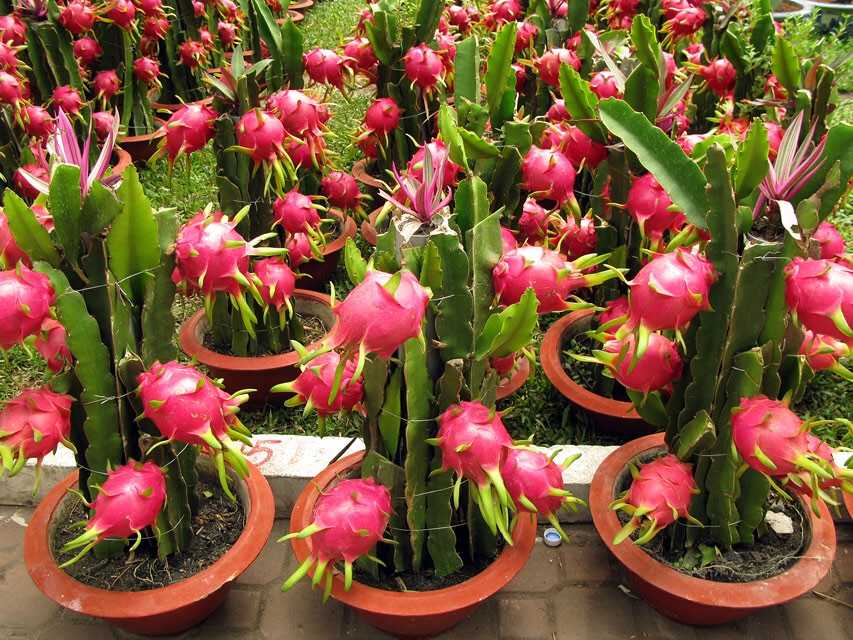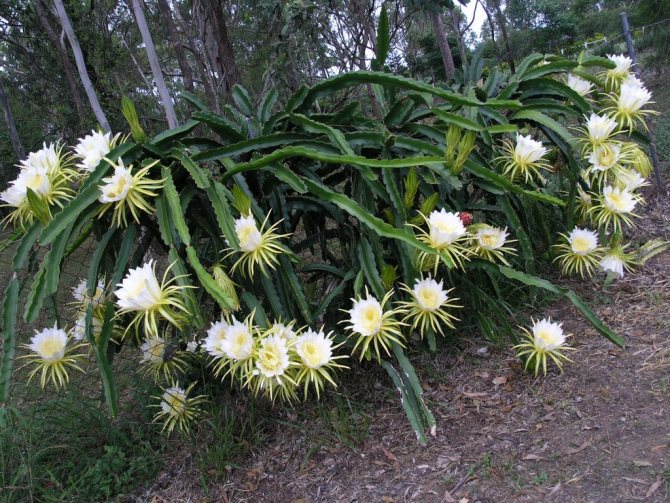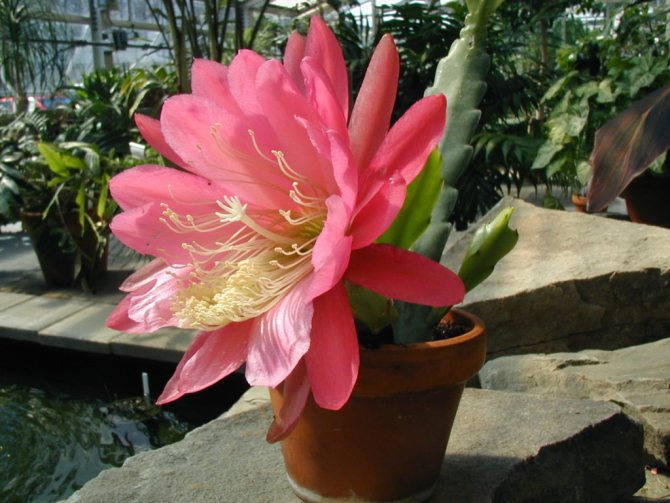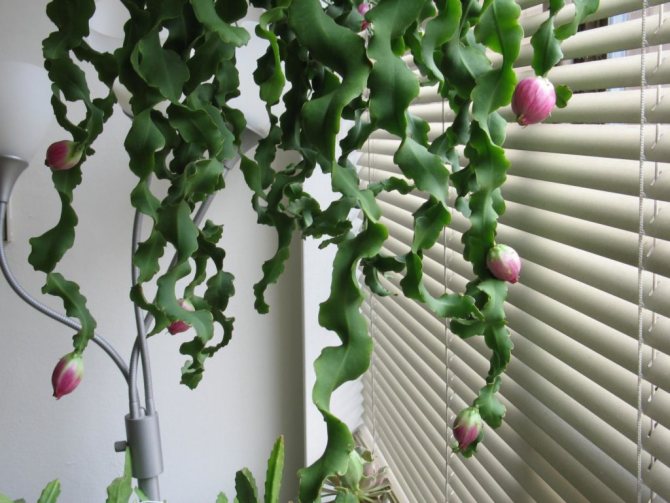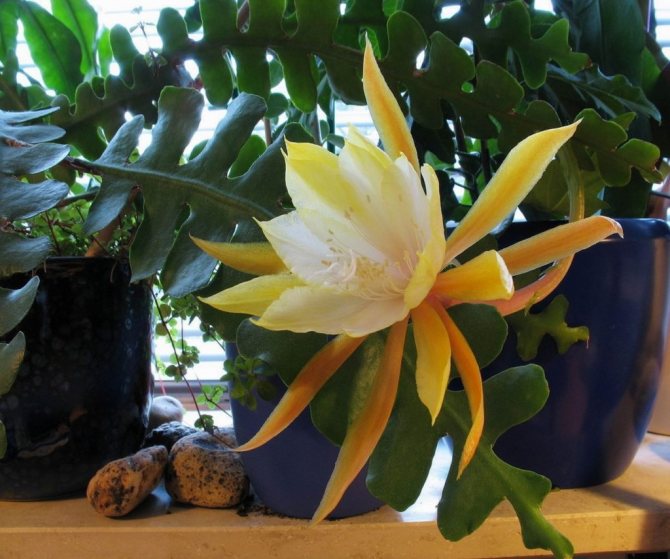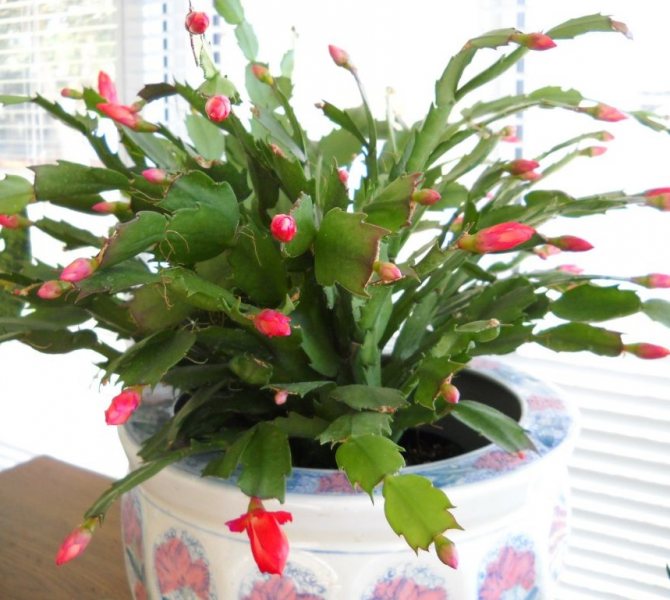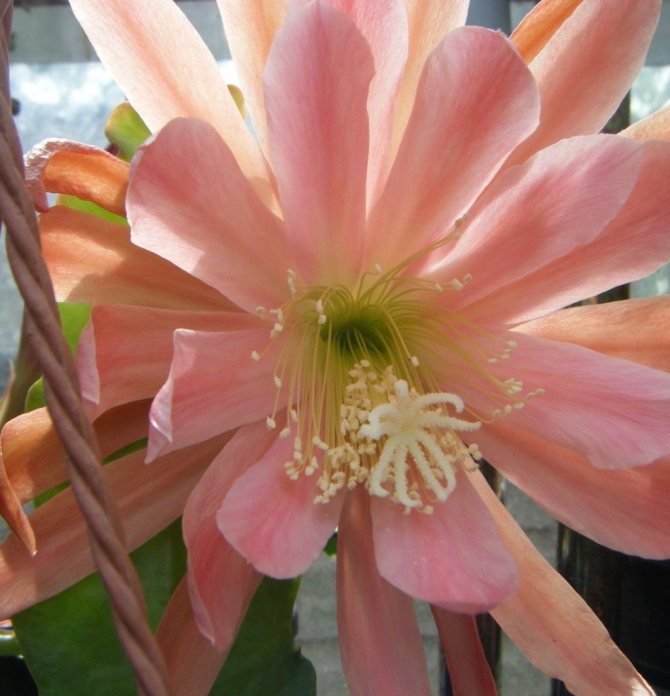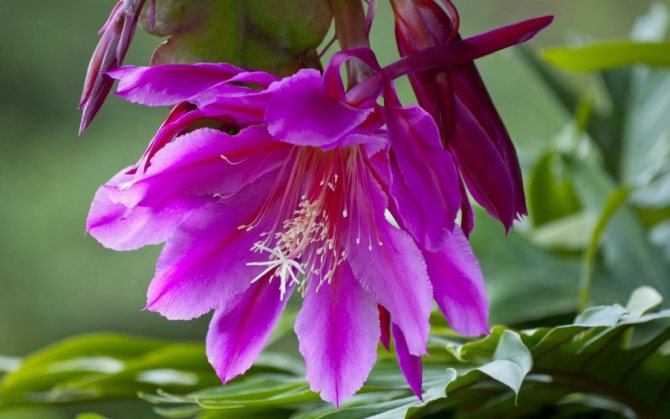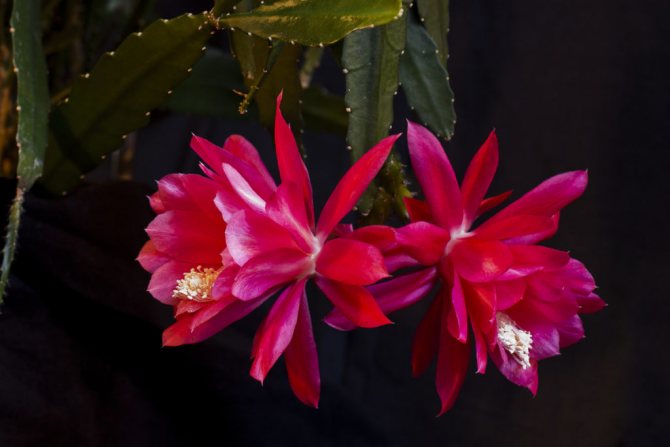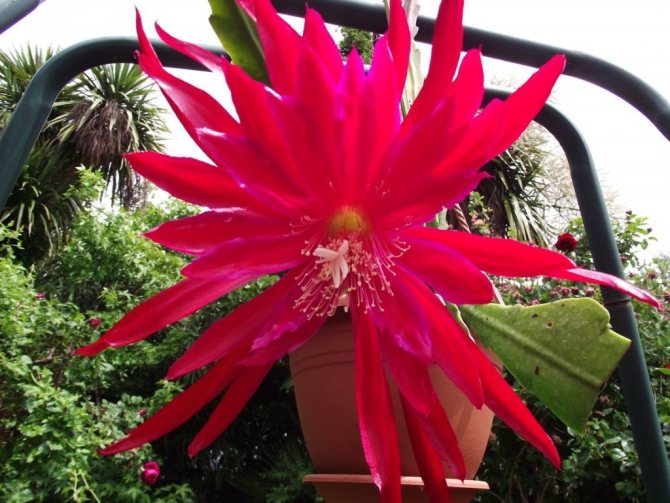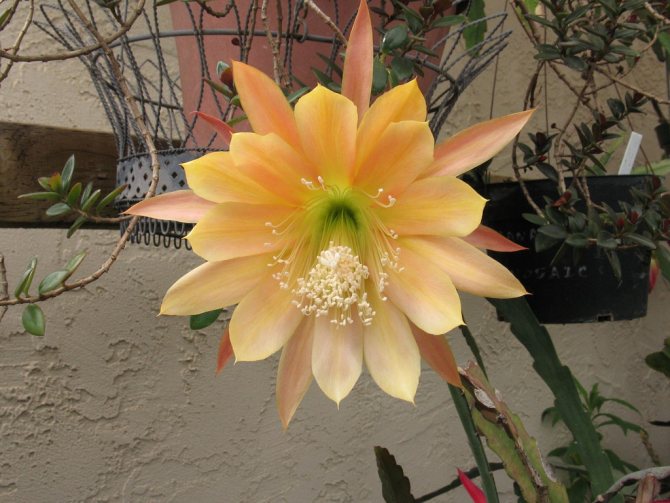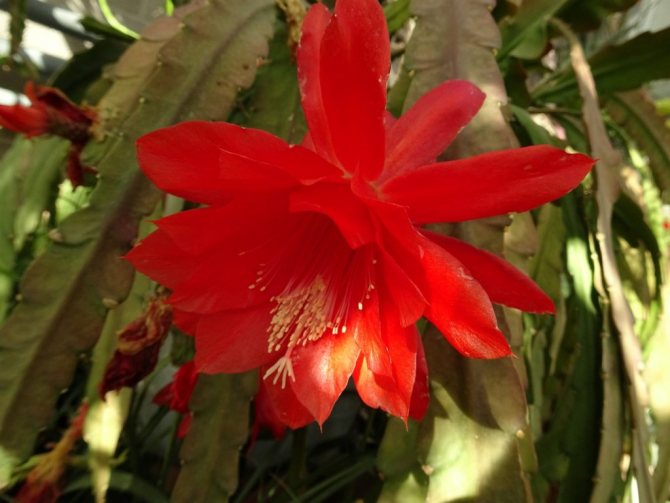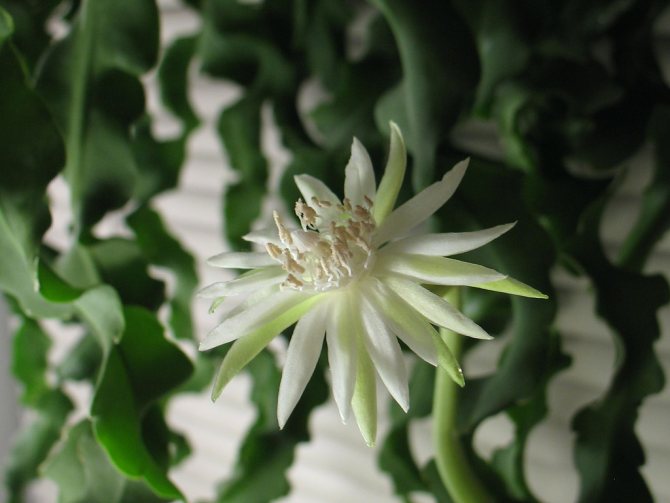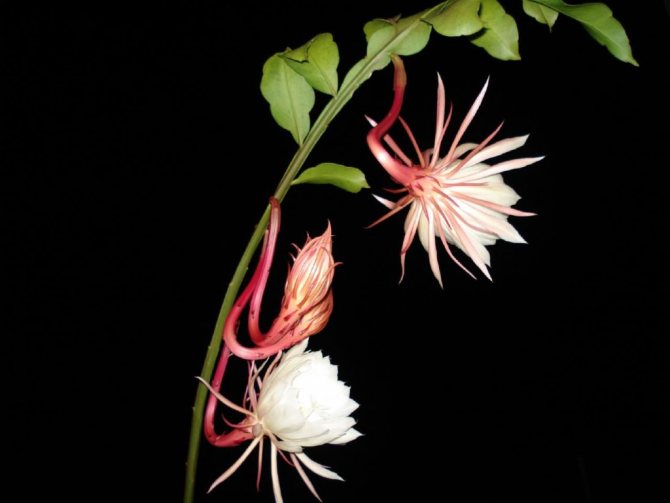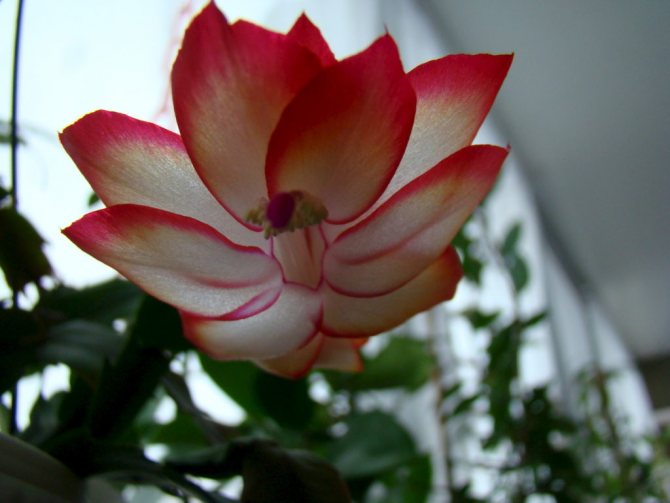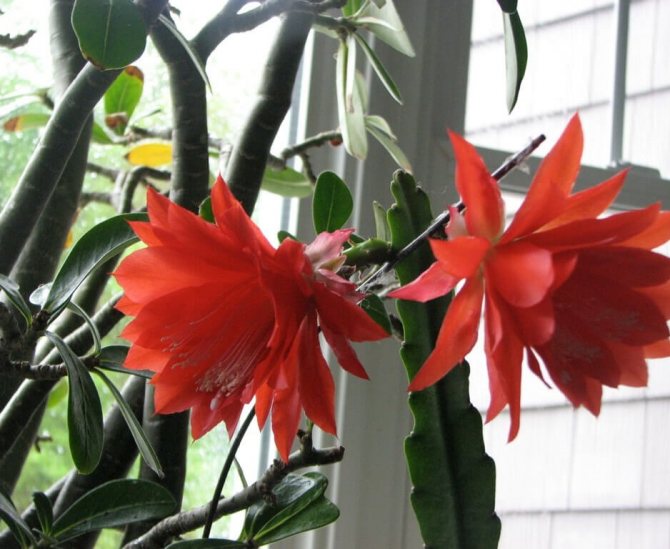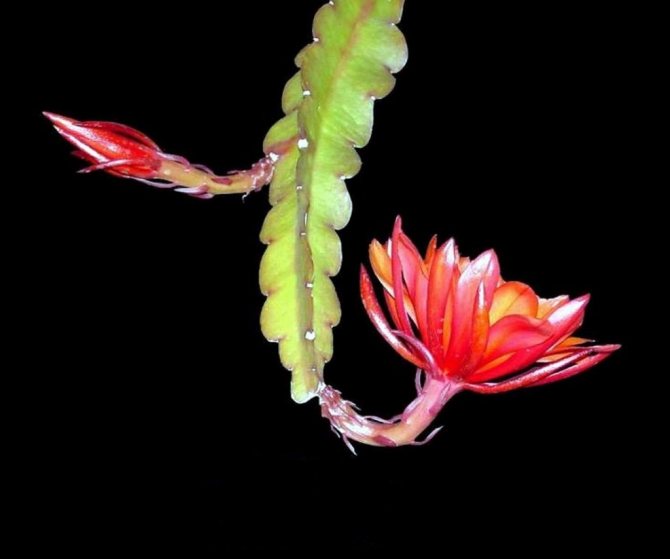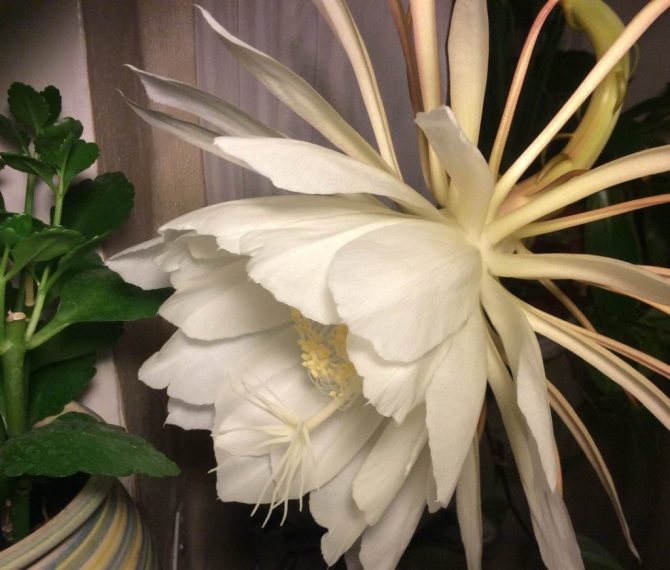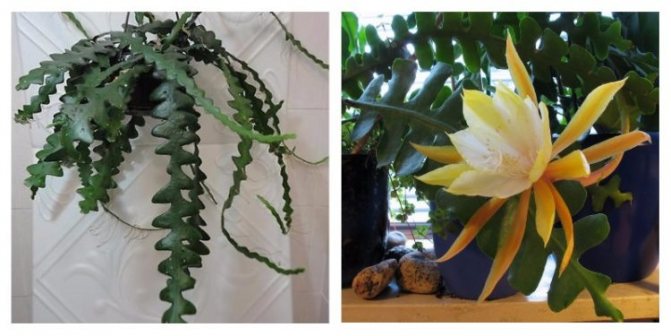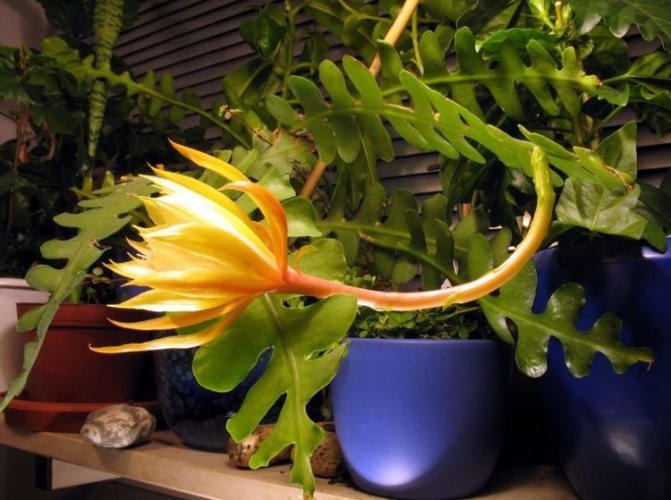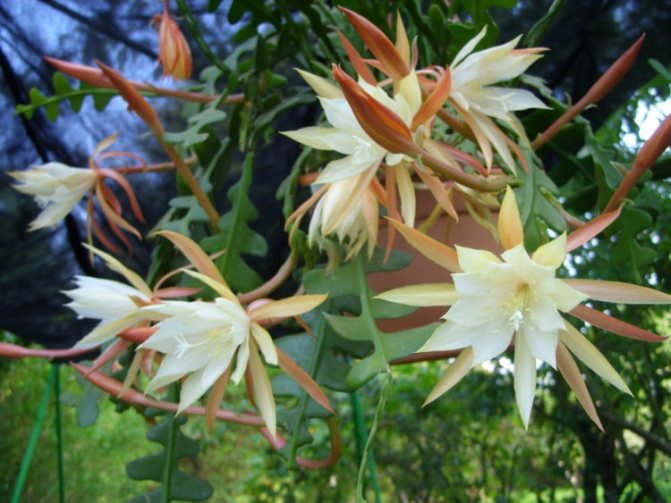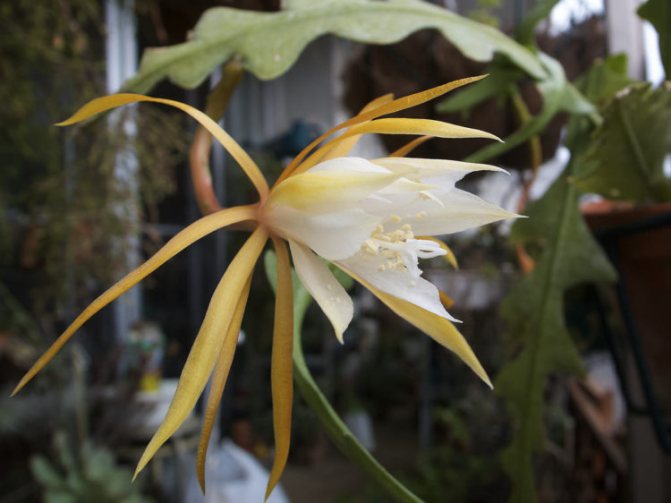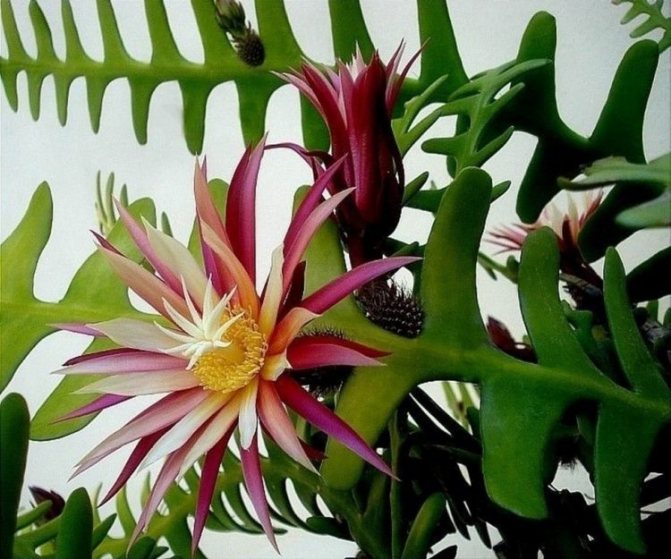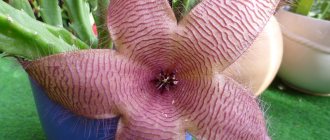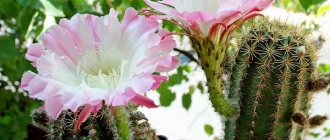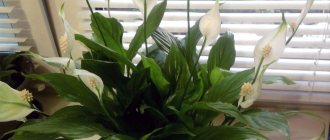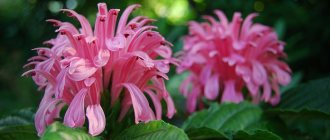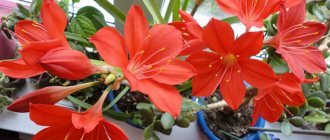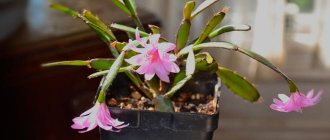A beautiful blooming cactus can single-handedly update a living space beyond recognition. Any landscape designer will tell you that tropical cacti are great for site recognition, but which particular species should you choose?
We recommend taking a closer look at the epiphyllum. This unusual variety takes root very well at home, and we will tell you how to care for this plant so that it grows beautiful and healthy. Let's get started.
Description of the epiphyllum
Epiphyllum (Epiphyllum), phyllocactus, it is also a forest cactus - a succulent plant belonging to the Cactaceae family, Distributed in the natural environment from Mexico to the tropical belt of America. In 1812, Adrienne Haworth discovered and described the plant.
The epiphytic cactus has long branched stems, they can be creeping or drooping. Stems are tetrahedral or flat. Due to the appearance, the stems are mistaken for leaves, but this is not the case, the plant does not have leaves.
The flowers are large (capable of reaching a length of 40 cm, can open during the day and at night), funnel-shaped, the color is mainly white, but there are forms with cream, yellow, pink, red flowers. The flowers are not only beautiful but also fragrant. After flowering, an edible fruit appears that has a banana-pineapple-strawberry flavor. It is large, reddish in color, often prickly.
Phyllocactus is very popular in home cultivation as an ampelous plant.
Photo gallery
How to care for epiphyllum at home
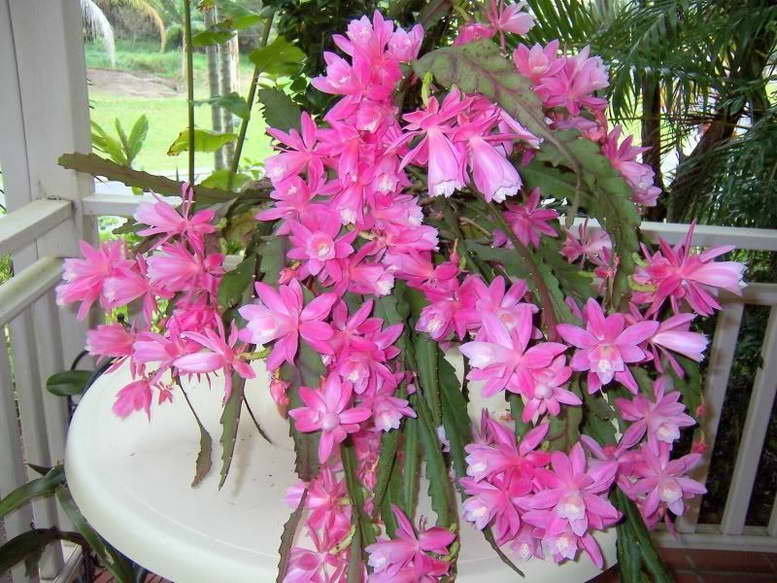
Epiphyllum flower how to care at home photo
Site selection and lighting
To make the epiphyllum bloom, you should place the pot with the plant on an east or west windowsill. Lighting is needed bright, but diffused. In summer, it is advisable to take phyllocactus outside - but be sure to protect it from direct sunlight, especially at noon.
Air temperature
The optimal temperature regime for a plant in the warm season is 20-25º C. During the rest period (November-February), the temperature should be lowered to 10-15º C.
Watering
The plant needs regular watering: more frequent in summer, less often in winter. Water as soon as the topsoil dries out in the pot. With a cool winter, watering can be stopped altogether. With the onset of spring, resume and gradually increase watering. It is enough to spray the plant only on the hottest days. For watering and spraying, use settled water at room temperature.
Top dressing
Epiphyllum requires a sufficient supply of nutrients. In spring and summer, it is necessary to apply a fertilizer solution for cacti to the soil twice a month. During the budding period, feed with a mullein: dilute 1 part of the fertilizer with 10 parts of water. At the end of flowering, apply top dressing once every 2 weeks, alternating organic matter with mineral nitrogen fertilizers. There is no need to feed during the rest period.
Pruning
Trim the epiphyllum periodically. Faceted or round stems must be removed (they never bloom), and flat stems must be shortened. Flowers appear on flat stems that have grown over the past year, on older stems that have already bloomed, buds will no longer appear, but to keep the plant alive, such stems can be removed after 2-3 years.Also remove twisted stems, stems growing into the bush and on which cork formations appear. Treat the sections with a fungicide.
Features of the flowering of the home flower of the epiphyllum
When winter comes to an end and the epiphyllum comes out of its dormant state, it begins to grow incredibly quickly and actively. It was at this time that future buds and, accordingly, buds are formed on its areoles. At this time, the most important thing that needs to be provided to the flower is not humidity or even lighting, but stability.
It must definitely stay in one place and move it is very undesirable, since otherwise the process of forming future flowers can be very disrupted. Also, strong shaking of the pot can be harmful, without which not a single movement of it can do.
Flowering, unfortunately, like absolutely all cacti, is very short-lived. It will begin in the spring when the buds are fully ripe and ready to bloom. And in five days they will fall off. Nevertheless, these five days are very important for the epiphyllum, since during these days it spends a lot of resources on maintaining flowers, and these resources need to be replenished, and therefore watering should be very abundant, like, in general, lighting.
Despite the short flowering of the epiphyllum, we still have something to please you with. The fact is that if you do everything right and take good care of the cactus, it can bloom again in the fall, rewarding you for your efforts.
How to make epiphyllum bloom and why it doesn't bloom at home
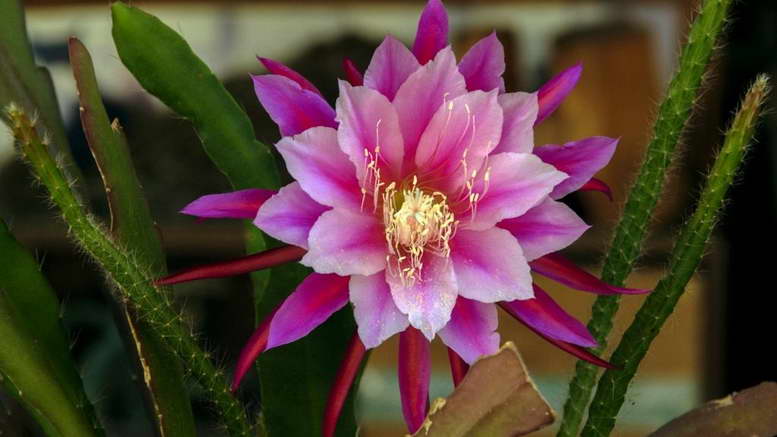

Epiphyllum indoor reproduction and home care photo of flowers
With the beginning of the formation of buds, the plant categorically cannot be rearranged or even simply rotated the pot with the plant, otherwise the phyllocactus will drop the buds. Flowers open in turn and delight everyone during the week. In some species and varieties, flowering occurs twice a year: in spring and autumn. Water abundantly during the flowering period, place the pot with the plant on a tray so that excess water flows out and does not stagnate in the roots. Don't forget about top dressing.
The reasons for the lack of flowering are as follows:
- Insufficient lighting
- Abundant watering during a cool winter
- Wintering in warm conditions
- Excess nitrogen in the soil
Flowering occurs only when the plant is kept in conditions that are comfortable for it. Check if there is enough light, moisture and the correct feeding regime (you should stop applying nitrogenous fertilizers). Be sure to keep the air temperature at 12 ºC during the dormant period (November-February). Under these conditions, the plant will surely thank you with flowering next season.
Other growing problems
Violation of the conditions and inappropriate care of the epiphyllum will be fraught with some other problems. For example:
- If your pet's leaves dry, wither and wrinkle, it means that he gets too much light and not enough water.
- If the epiphyllum stopped growing when the “place of residence” was changed, the buds and flowers fell off, and the leaves changed in color, look for another place for it.
- If, after transplanting, the stems dry and die off, then you inadvertently damaged the roots.
- Cracking shoots will indicate that you are applying too much fertilizer to the soil.
Be attentive to the care of your phyllocactus. A problem detected in time and the correct treatment will help you keep the bush healthy and beautiful.
Epiphyllum transplant
Young, fast-growing phyllocactus require annual replanting in the spring. Transplant adult specimens as needed (when roots begin to peek out of the drain holes), do this after flowering. The container needs a wide and not deep one. A ceramic or heavy-duty plastic pot works best.
At the bottom, be sure to lay a drainage layer made up of pieces of foam, expanded clay, pebbles.As a soil, a substrate for succulents or cacti is suitable. The following soil mixture is suitable: 4 parts each of leaf and sod land with the addition of 1 part of coarse sand, charcoal and fibrous peat. After transplanting, place in partial shade, water in moderation.
Interesting facts about the plant
This cactus is actively used for medical purposes to treat pathologies of the heart and blood vessels, stomach and intestines. It is also used to treat neurological diseases. It protects the human body from the effects of electromagnetic radiation.
The juice of the plant is used for migraines, colds, rheumatism. It is a natural diuretic, thickens the blood during bleeding, relieves hangover syndrome. And also they can treat psoriasis, reduce inflammation. It speeds up tissue repair and helps cleanse the blood. Treatment with herbal tinctures is effective for stress and apathy.
Pests and diseases and epiphyllum
Pests
The succulent stems of the plant attract the attention of sucking insects: aphids, scale insects, spider mites, mealybugs. They not only provoke a wilted plant species, but scale insects and aphids are carriers of viral diseases. First, remove the pests mechanically: moisten a sponge or cotton swab with soapy water and wipe the stems of the plant. Then carry out the insecticide treatment, repeating after a week.
Consider plant diseases
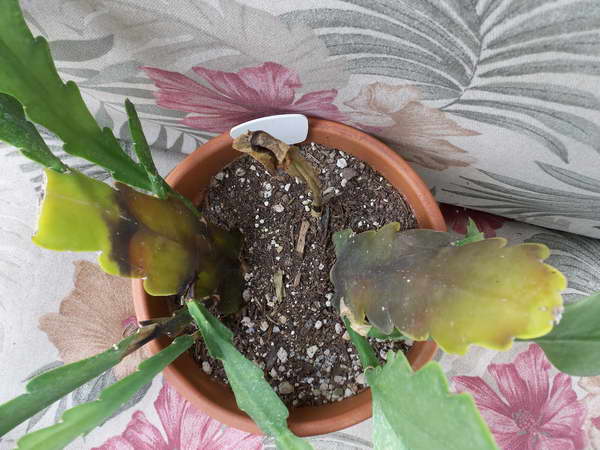

Epiphyllum diseases - black rot photo
Black rot - the stems of the plant are covered with black shiny spots. It is necessary to remove the affected areas. Treat the plant with Fundazole.
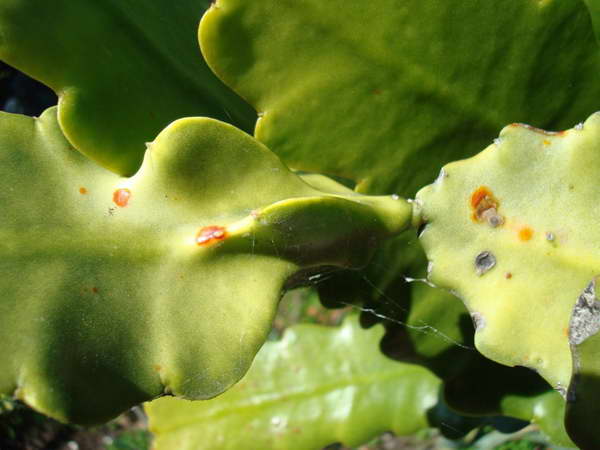

Epiphyllum diseases - rust photo
Rust appears as red spots on the stems. This happens for a number of reasons: sunburn, falling of water droplets on the stems when watering, excessive watering at a cool air temperature. It is necessary to treat the plant with Topaz.
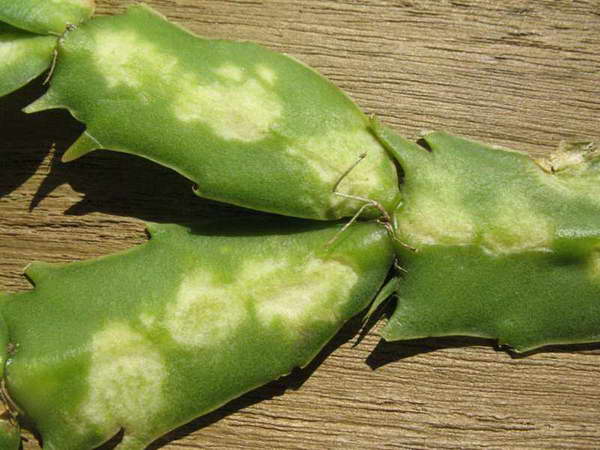

Mosaic disease on the epiphyllum photo
Mosaic disease is a viral disease that is fatal to a plant. At the first symptoms, quarantine the plant, remove all damaged areas, treat the green mass and soil with phytosporin several times at intervals of 10 days. If the disease progresses, destroy the plant so that there is no contamination of neighboring specimens.
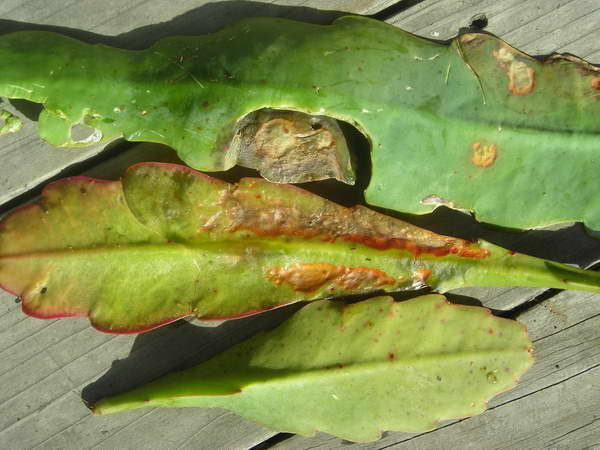

Anthracnose on epiphyllum photo
Anthracnose - light brown spots on the stems. Actions: cut out the affected areas, treat with a fungicide.
Fusarium - rotting of the root system, manifested by the change of the green color of the stems to reddish, brown. The roots can rot not only because of this disease, but also when making mistakes in care (excess moisture, watering with cold water, overheating due to prolonged exposure to the sun). There is always one escape route - an emergency transplant. Remove damaged roots, treat the sections with a fungicide. After transplanting, it is best not to water for a while, then adjust the watering.
Care errors and their consequences:
- From bright light or lack of watering, the stems dry out and wrinkle
- If the root system is damaged during transplantation, the stems will begin to dry out and die off.
- The shoots will crack from the excess of nutrients.
How the plant is sick and methods of treatment
Sometimes the forest cactus Epiphyllum is affected by the disease, like any other plant. It is better to remove problematic, incurable fragments together with the stem, the cut of which is sprinkled with charcoal for healing.
| Disease | Cause | Treatment method |
| Light small spots on the stems | Viral mosaic | Cut off the problem area |
| Hard ring spots | Fungi of various origins | Cut off the problem area |
| White grains all over the surface | Mealybug | Cut off the problem area; or treat with soapy water for several hours; or spray "Akarin", "Fitoverm" and other means |
| Deformed stems, dull flowers, colonies of greenish pests visible to the naked eye | Aphid | Rinse under running water. Cut off the problem area; or spray with infusion of onion juice, garlic, mustard, soap, alcohol, acarin, phytoverm |
| Sluggish stems, fallen buds, brown spots on the surface | Shield | If the disease is mild, it can be covered with soapy water for a couple of hours. With a severe progressive disease, folk remedies rarely help, it is better to spray with phosphate, actellic |
| Slime streaks, wilting | Slugs | Harvest manually |
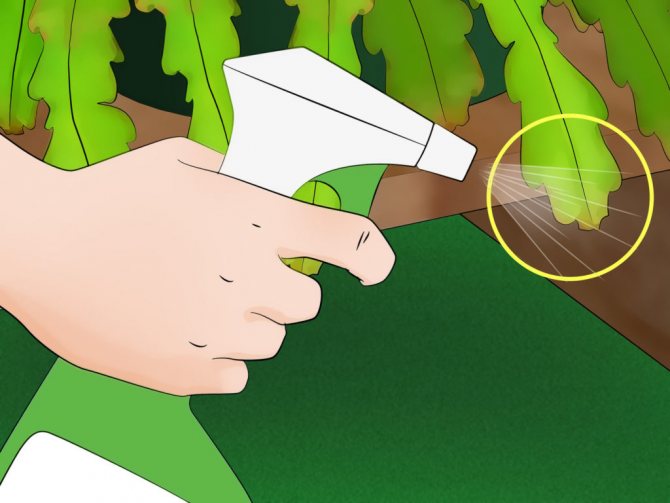

The picture clearly shows the process of spraying the damaged brownish areas of the stems with a certain preparation. If it is a commercial product based on chemicals, it is better to protect your hands with gloves.
Growing epiphyllum from seeds
Epiphyllum seeds photo
Seed and vegetative (by dividing the bush, stem cuttings) reproduction is possible
Propagating phyllocactus by seed is quite simple. It is necessary to fill the bowls with the succulent substrate, moisten the soil and distribute the seeds over the surface. Cover crops with foil, maintain air temperature within 20-23ºC. Do not forget to ventilate daily for 30 minutes.
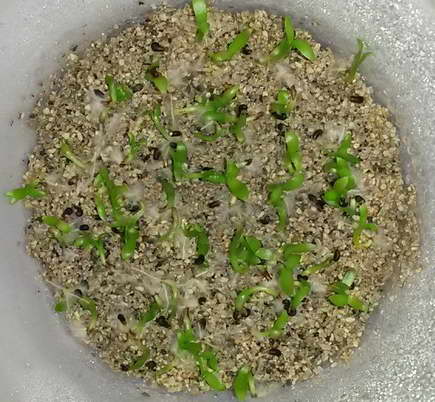

Epiphyllum from seeds photo of seedlings
With the emergence of shoots, remove the film completely. The sprouts will look like small faceted cacti with thorns - over time they will become flat and the thorns will fall off. Expect flowering years 4-5.
Features of seasonal care
During the year, the plant experiences periods of active growth and relative dormancy. In the fall, all vital processes are inhibited, during the winter the flower rests. During this period, it is desirable to provide him with cool air (+ 10..15 ° C). There is no need to highlight the plant additionally. But if it hibernates in a warm room, you will have to turn on the backlight in the evening. Water the flower 1-2 times a month. It is necessary to resume abundant watering in the spring, gradually increase them. There is no need to feed the cactus in winter.
Dividing the bush
Divide the bush when transplanting an adult plant. Remove the phyllocactus from the pot, divide it into parts so that each division has healthy, young stems and strong roots. Cut off dry, rotten areas, treat with a fungicide. Plant in separate pots with drainage and substrate suitable for growing epiphyllum. For adaptation, partial shade and minimal watering are required.
Pest control
What pests should be feared when growing epiphyllum:
- mealybugs;
- aphids;
- spider mite;
- scabbard.
All of these insects feed on the sap of the plant, drying it out and slowing down its growth.
The presence of mealybugs produces a white bloom on the stems, similar to cotton wool. The fight against this pest consists in the mechanical removal of parasites, for which a brush or a piece of cloth moistened with alcohol or soap solution is taken. Then the flower is treated with Aktara, Confidor, Mospilan or Fitoverm.
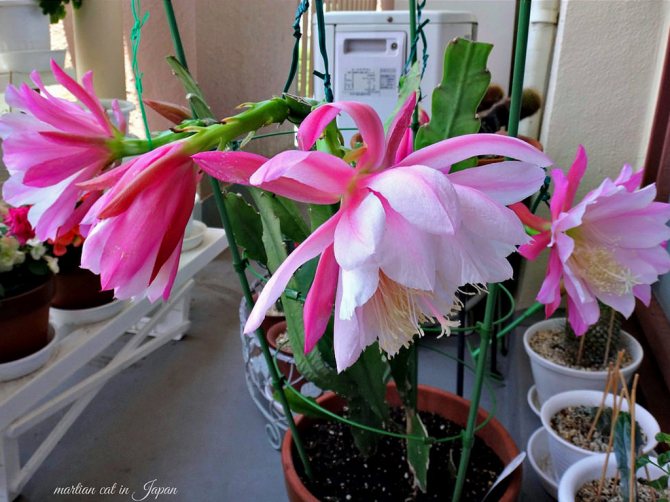

Everyone is probably familiar with small aphids. To lime it, you can use Antitlin or Biotlin.
The spider mite usually appears when the plant is not spoiled by watering. Insectoacaricides - Aktara or Aktelik will help to destroy it.
A pest called a scale insect, which are small hard bugs, as well as a mealybug, is first removed mechanically. Then phyllocactus is treated with an insecticide.
Propagation of epiphyllum by cuttings
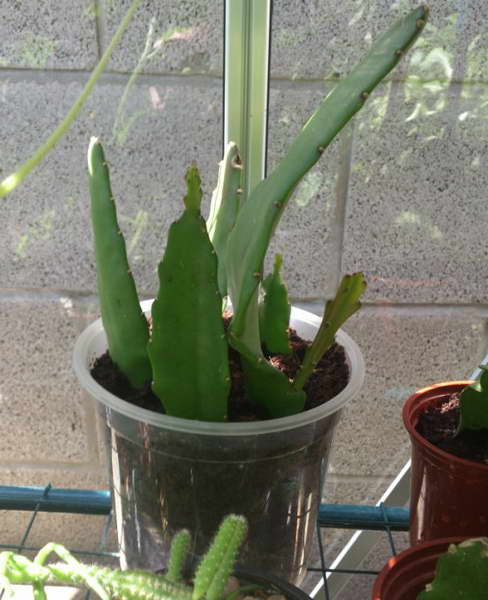

Epiphyllum cuttings photo
Carry out cuttings from the beginning of April to the end of May.
- Divide the stems into pieces 10-13 cm long.
- Make a wedge-shaped cut along the bottom, place the cutting in a dry empty container for a couple of days to dry the slices, then plant it in the ground, deepening 1 cm.
- Soil composition: 3 parts of light soil with the addition of 1 part of perlite, after planting, sprinkle the surface of the soil with a layer of sand (about 2 cm thick).
- Root in the shade, start watering 2 days after planting.
Phyllocactus fruits
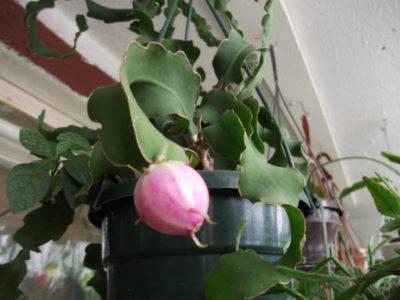

Epiphyllum is able to bear fruit even at home. This requires artificial cross-pollination. The fruits are often covered with thorns, similar in shape and size to a plum. Their color depends on the shade of the flowers.
There are yellow-green or purple fruits. You can eat them. The pulp has a pleasant sweetish taste, reminiscent of a mixture of pineapple and strawberries. The fruits are eaten separately, like fruits or berries, and are also added to various dishes. Pre-cleaned of thorns. The fruits are used in folk medicine. On the basis of the pulp, infusions, ointments and compresses are prepared.
These funds help in the treatment of headaches, colds, diseases of the cardiovascular, genitourinary and nervous systems, gastrointestinal tract, diseases of the skin and joints. The fruits are especially widely used in the fight against psoriasis.
Types and varieties of epiphyllum with photos and names
Consider the popular types and varieties of epiphyllum in cultivation.
Epiphyllum oxypetalum aka Epiphyllum oxypetalum
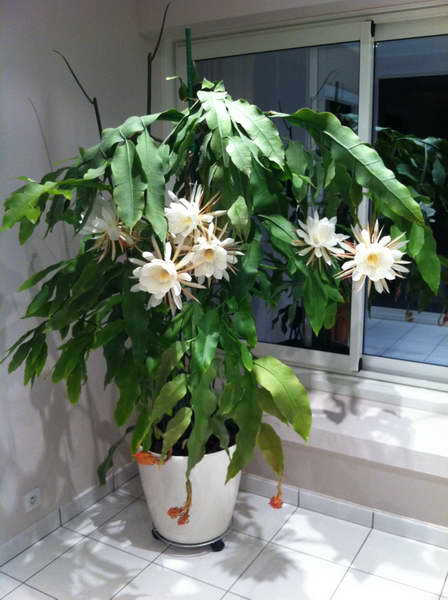

Epiphyllum oxypetalum aka oxypetalum Epiphyllum oxypetalum photo
The plant is large, reaches a height of about 3 m. Shoots are rod-shaped, flat, wavy at the edges, lignified in the lower part. The stem is 10 cm wide. The flowers are huge: up to 20 cm long and about 18 cm in diameter. The color is white, hybrid forms can have different colors.
Epiphyllum anguliger or angular Epiphyllum anguliger
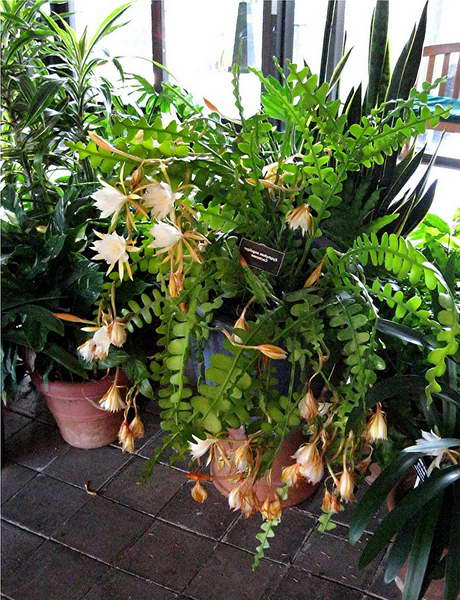

Epiphyllum anguliger or angular Epiphyllum anguliger photo
The bush is highly branched. The lower stems are rounded, sometimes triangular, woody, the upper ones are flat or triangular. The stem is about 1 m long and 4-8 cm wide. The color is dark green. The flowers are large (4-8 cm in diameter), painted in bright red.
Hooker's Epiphyllum Epiphyllum hookeri
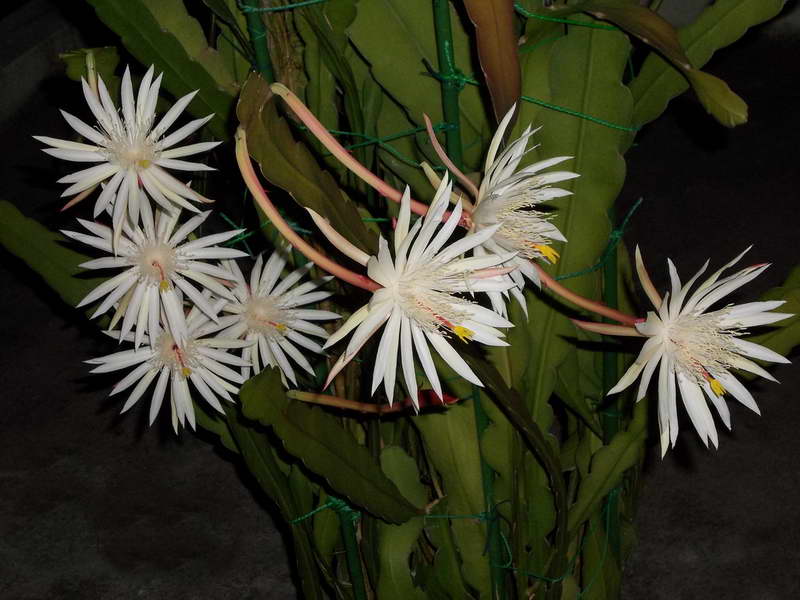

Hooker's Epiphyllum Epiphyllum hookeri photo
Originally from Cuba. It has long stems, which, under the weight of their own weight, bend in an arc and fall to the ground. The flowers are white.
Epiphyllum serrated Epiphyllum crenatum
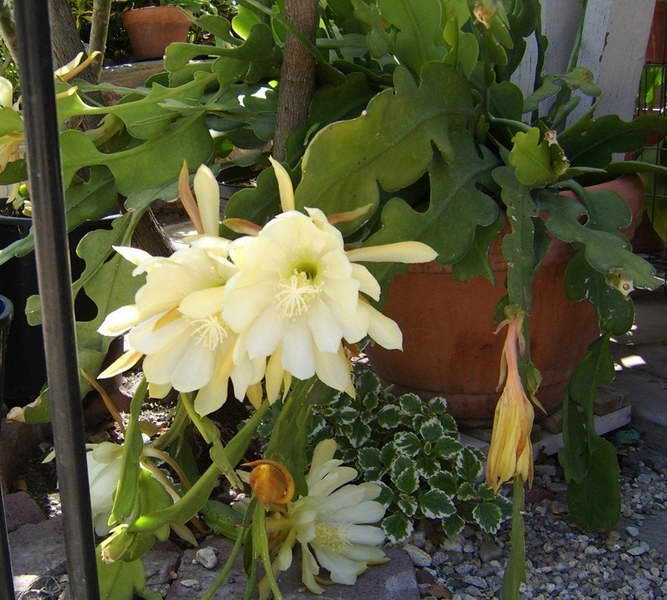

Epiphyllum serrated Epiphyllum crenatum photo
Semi-epiphytic plant with stems 70 cm long and up to 10 cm wide, their color is bluish-green. The stems are carved along the edges. The diameter of the flower is 15 cm. The color depends on the hybrid form.
Epiphyllum phyllanthus Epiphyllum phyllanthus
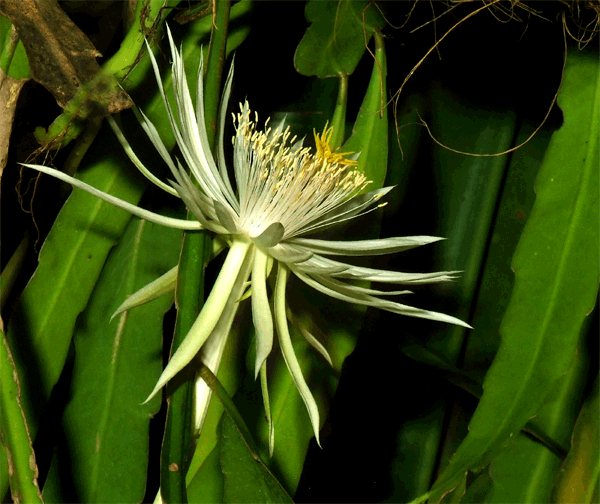

Epiphyllum phyllanthus Epiphyllum phyllanthus
Originally from South America. Shoots reach a length of 1 m, secondary flat stems are 25-50 cm in length. The flowers are pink, the diameter of the corolla is 15-18 cm.
Epiphyllum guatemalan Epiphyllum guatemalense
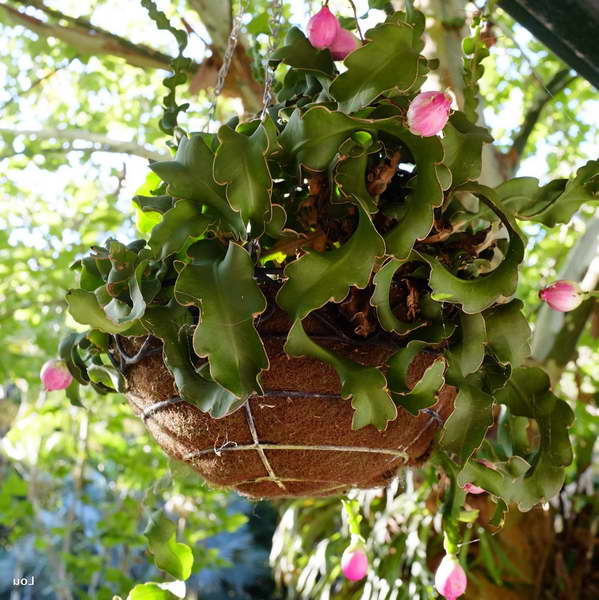

Epiphyllum guatemalan Epiphyllum guatemalense photo
The stems are a chain of successively connected parts, similar in shape to oak leaves. The size of each "link" is 5 cm in length. Flowers have a variety of colors.
Epiphyllum Thomas Epiphyllum thomasianum
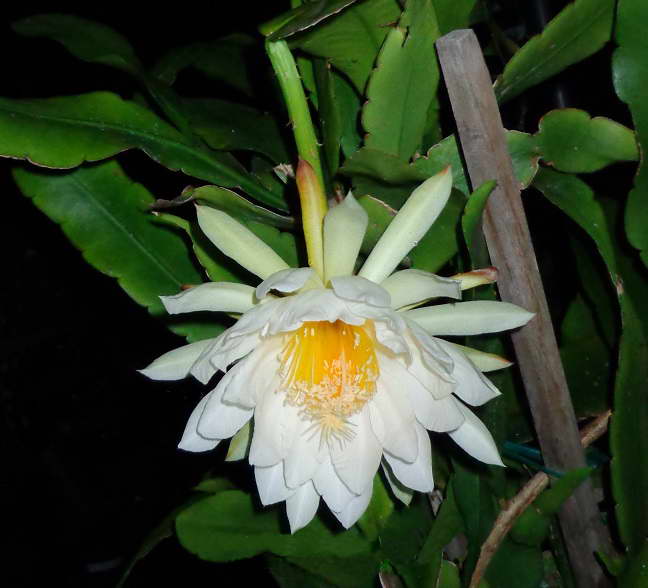

Epiphyllum Thomas Epiphyllum thomasianum photo
In the natural environment, the stems reach a length of up to 4 m, in room conditions they are limited to 70 cm. Flowers with a diameter of 25 cm are white, the core is yellow.
Epiphyllum Ackerman Epiphyllum ackermanii
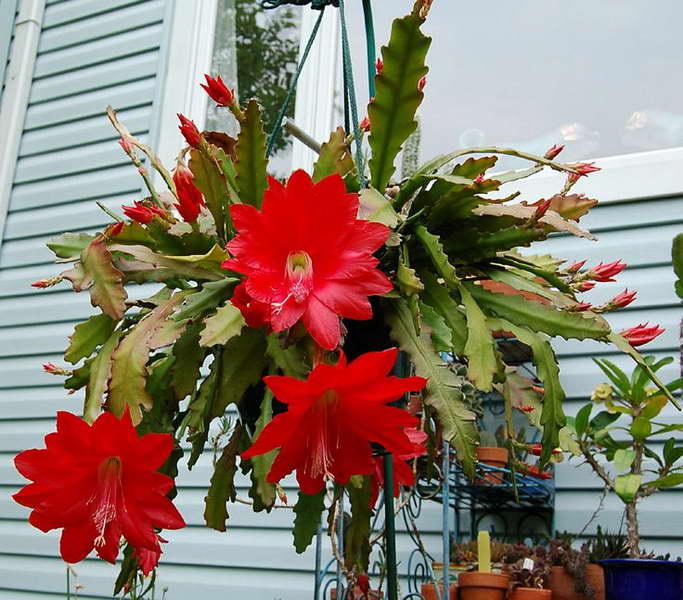

Epiphyllum Ackerman Epiphyllum ackermanii photo
Hanging stems, flat serrated processes are located at the level of 4-7 cm from the base. Flowers of a fiery red hue, they are attached to thin pedicels.
Epiphyllum Lau Epiphyllum laui
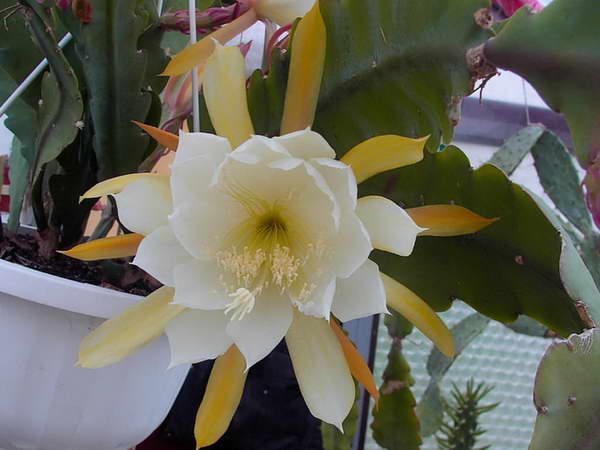

Epiphyllum Lau Epiphyllum laui photo
The main stems of the plant are 2 cm in diameter, the lateral ones are about 7 cm. The shoots are covered with hair-like needles about 4 mm long, their color is yellowish-brown. Flowers of a white-cream shade open in the evening and flaunt within 2 days.
Popular hybrid forms of epiphyllum:
- A hybrid bred by Frank Nunn (unnamed) - the middle of the flower is painted white, gradually turns into light pink, and the edges are bright purple.
- King Midas - stems are dark green, up to 1.5 m long. Large flowers with a diameter of about 16.5 cm are yellow-orange, almost gold in color.
- Just Prue - has flowers with a diameter of 12-16 cm, color: light pink middle turns into dark pink edges.
- Epiphyllum Johnson - dark scarlet flowers.
- Wendy Mae - the color of the flowers is bright crimson. The shape of the corolla is unusual: in the middle, the petals are short, rounded, and the outer ones are long, have pointed edges.
- Jennifer Ann - has bright lemon-colored flowers.
- Martin - the stems are falling, consist of oval-shaped segments. The flowers are funnel-shaped, with a light yellow center passing over the edges of a reddish color. The bloom exudes a pungent aroma.
Care errors and their elimination
The table contains information about common problems when growing Epiphyllum and ways to eliminate them:
| Problem | The reasons | Decision |
| Slow growth | Insufficient lighting, excess moisture, unsuitable soil | Move the flowerpot to a brighter place, change the soil and reduce watering |
| Drooping leaves | Insufficient soil moisture | Increase watering |
| Drying and wrinkling of leaves | Too intense lighting, insufficient watering | Move the plant to the west or east window, increase watering |
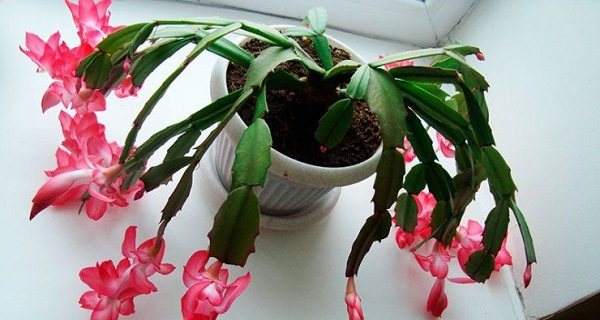

Cactus, but does not grow in the desert
Epiphyllum is a forest cactus. Desert relatives are only reminiscent of the small and rare needles that the plant has. Moreover, the fact that the epiphyllum has no leaves at all, only their rudiments. But there is a stem, flat with angular edges.
This leaf-like stem misled the English botanist Adrian Haworth. More than two hundred years ago, in 1812, a scientist discovered a new species of semi-shrub plants in the tropics of South America. He was lucky enough to see luxurious flowers bloom at the ends of the epiphyllum stems. Haworth described the plant and named it Epi phyllum, which in Greek means "on top of the leaf." Later it turned out that the botanist was mistaken: the epiphyllum does not have leaves.
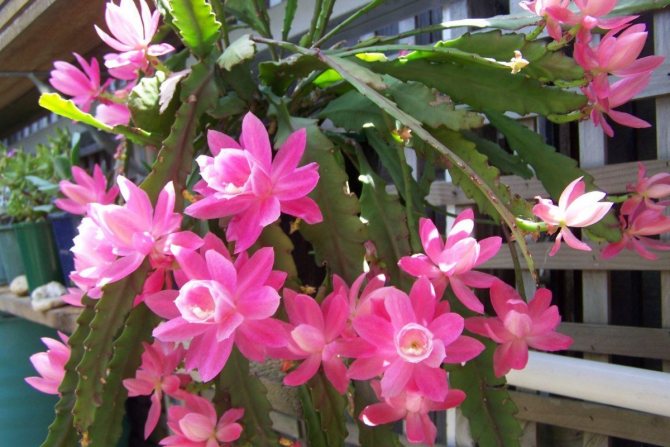

The plant has stems and flowers, but no leaves.
Epiphyllum at first glance is rather plain, even sloppy. Rigid ribbed flower stems, reaching a length of 70 cm, bulge in all directions. But once the flowers bloom, the slob transforms into a handsome man. Luxurious flowers (in some species they reach 18 cm in diameter), resembling a funnel, are striking in their beauty, and sometimes they smell wonderful... Delighted fans of the epiphyllum called their favorite "cactus-orchid" for the beautiful flowers.
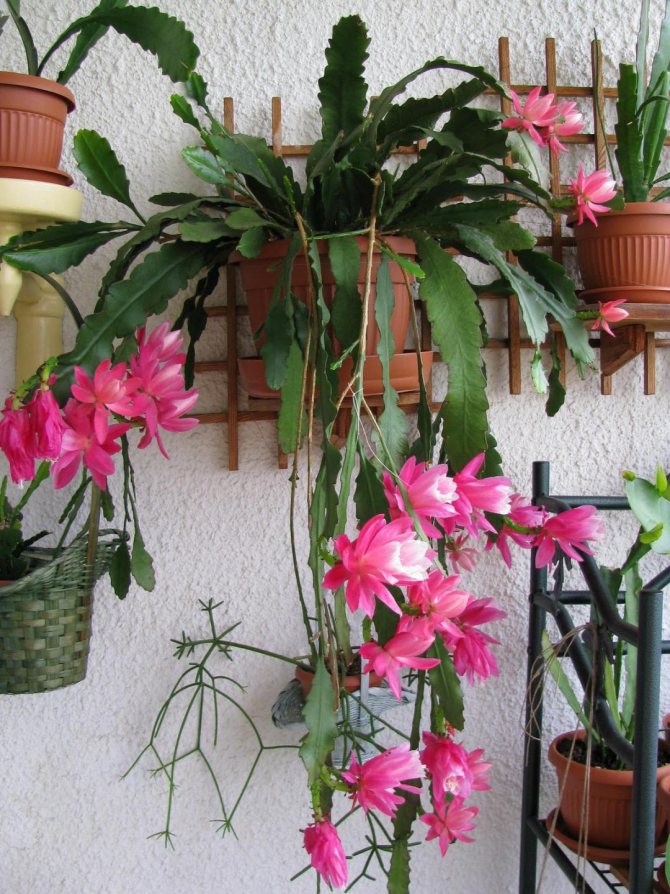

Epiphyllum will bloom not only on the windowsill, but also in the wall pots
Try it! In the wild, the epiphyllum bears fruit. A domesticated plant can also bear fruit. But for this you have to do the pollination of the flower. Anyone who has successfully completed the work of a bee will harvest prickly crops, the size of a plum of edible fruit. Inside they are juicy, they taste like pineapple and strawberries at the same time.
Choosing a strong seedling
Caring for the plant will be easier if you are careful when purchasing it. The epiphyllum should look like this:
- stems are rich green, elastic and dense;
- no spots on stems, broken or sluggish shoots;
- the pot is clean, no cobwebs or mold;
- no buds.
Important! Resist the temptation to buy a set-bud epiphyllum. They will fall off during transport. And on these areoles, buds will no longer appear, since they bloom only once in a lifetime. This means that you will not achieve flowering from this plant for the next two years.
Spotted stems and other problems
Table: correcting care errors and saving treatment from diseases
| Problem | Cause | Elimination |
| Epiphyllum stems wither | Root decay due to waterlogging of the soil: most likely, the cactus was flooded | Reduce watering, replant the plant by removing rotten roots |
| Buds appeared but fell off | Plant movement or excessively bright light | Do not disturb the plant, if it was not possible to achieve flowering, remove the aged stems by the next season, they are triangular in shape |
| The tips of the shoots dry up, and the stems are covered with ring-shaped spots, similar to a cork tree | Fungal or viral infection | The plant does not respond to treatment. To prevent the infection from spreading, the flower is destroyed |
Epiphyllums are not very affected by pests. But still, this flower has enemies. Therefore, inspect the plant more often to identify pests and begin to fight them in a timely manner.
Table: how to save a forest cactus from pests
| Pest | Sign | Way to fight |
| Spider mite | Cobwebs on the stems |
|
| Aphid | Insects are visible on the flower | Purchase aphid remedy in a specialized store, follow the instructions. |
| Mealybug | Cotton-like plaque on the stems |
|
| Shield | Brown plaques on stems |
|
| Slugs | Insects leave behind silvery lines of dried mucus | Spread the granules of the Thunder or Meta preparations under the plants. |
Photo
then you can see the photo of the plant:
Bloom
Bud formation occurs after the end of the dormant period, in early spring. Also, the plant shoot thickens and the active growth phase begins. It is important not to disturb the flower at this time, as this can damage the inflorescences. Usually, flowers last up to five days.
Fertilizing, spraying and reasonably generous watering of the cactus during this period will not be superfluous. Then, strikingly beautiful yellow flowers will be even more attractive.
If you are interested in learning how to make the epiphyllum bloom and what varieties of this plant can delight you with beautiful flowers, then we suggest reading this article.
Varieties: almost any flower except blue
Two dozen types of epiphyllum were created by nature itself. Breeders have increased their number by 10 times. They bred hybrid varieties that can be grown traditionally on the windowsill and hung in pots like ampelous plants. But special attention is paid to the flowers of the epiphyllum. They come in a variety of colors, literally the entire rainbow spectrum, except for blue.
Among amateur flower growers, the following are especially popular:
- the epiphyllum is angular,
- epiphyllum phyllanthus,
- Hooker's epiphyllum,
- serrated epiphyllum,
- Ackerman's epiphyllum,
- epiphyllum Just Pru.
Photo gallery: popular varieties of epiphyllum with different color of flowers
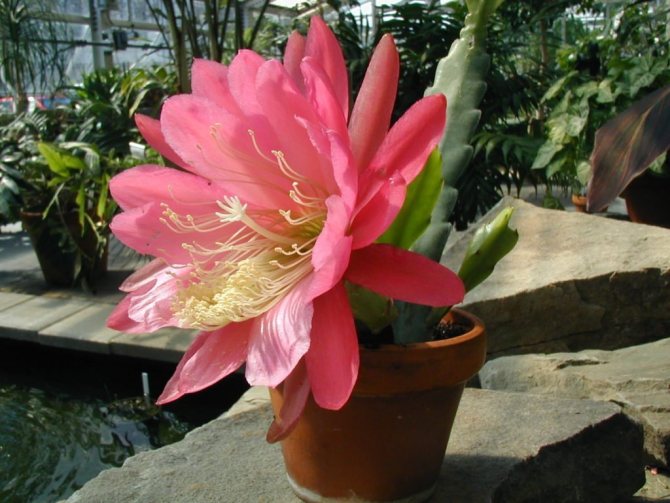

This showy pink flower is a hybrid variety of Epiphyllum Just Pru
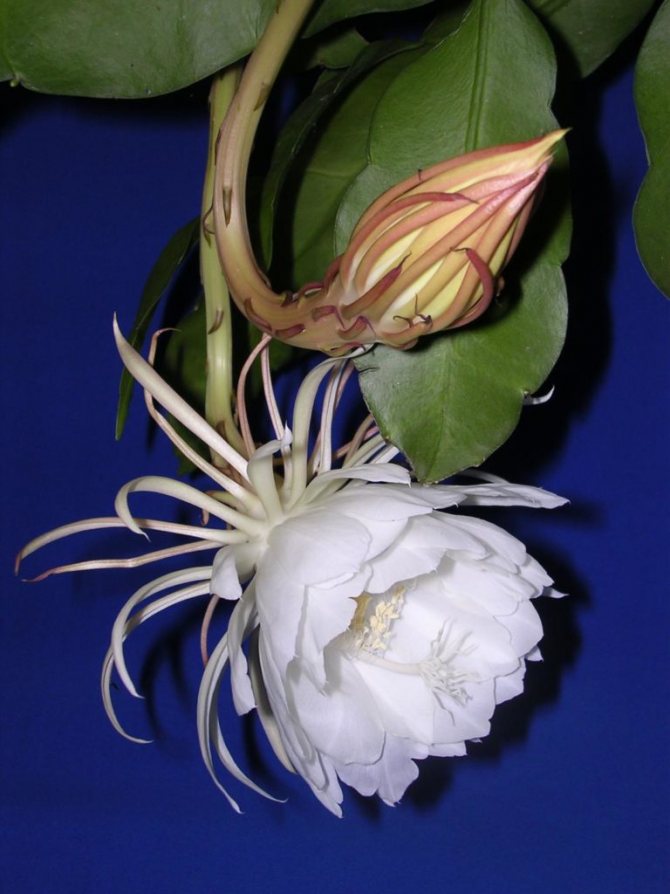

Hooker's epiphyllum has snow-white flowers
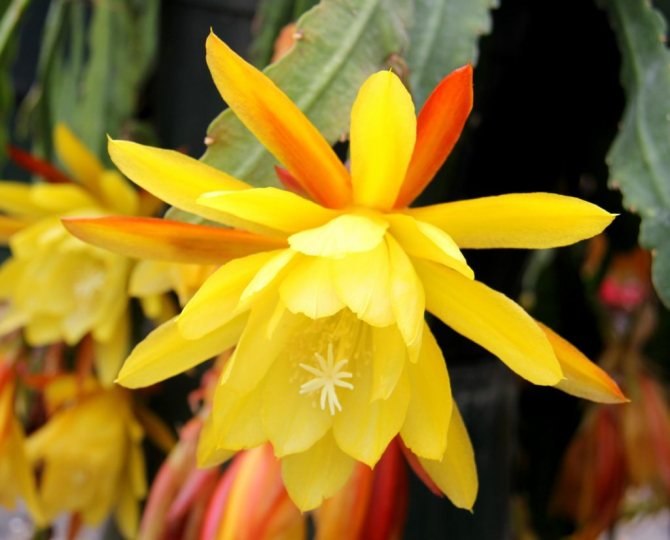

Ackerman's epiphyllum flower can be red, white, but the most beautiful is yellow
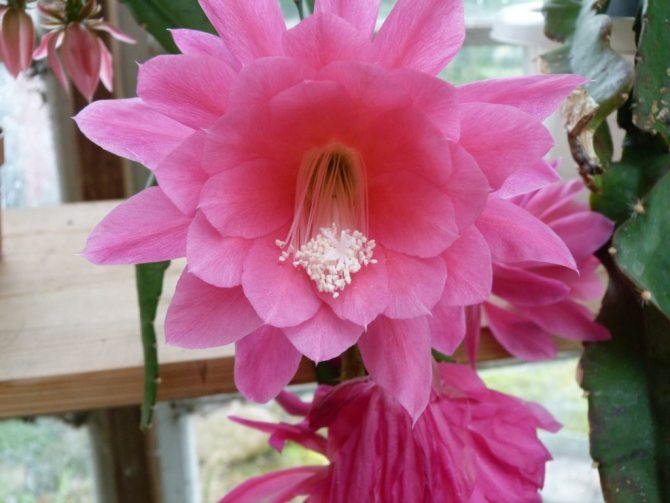

Epiphyllum phyllanthus - a large plant, but also a flower up to 18 cm
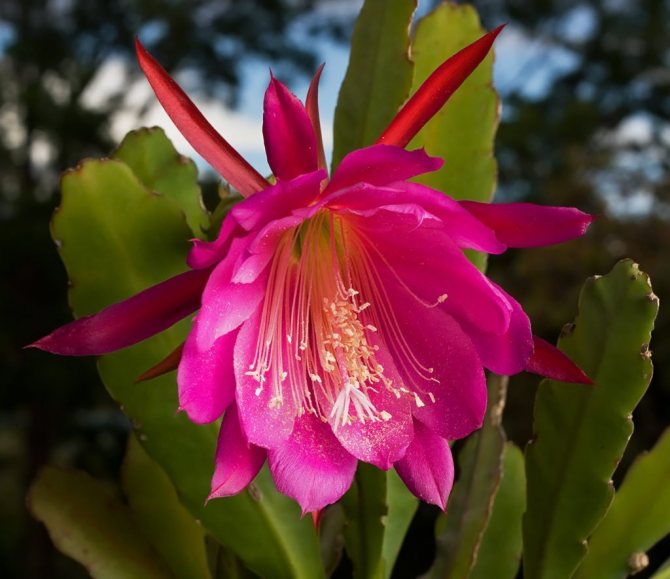

Hybrid Wendy-2 - a minimum of greenery and a huge flower
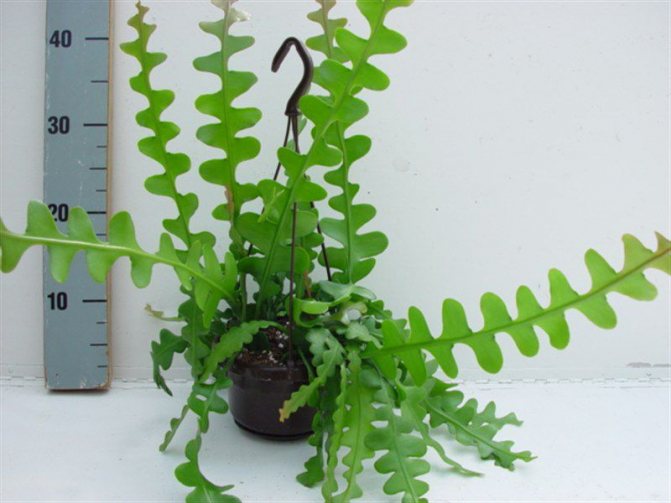

The angular ephiphyllum has a very spectacular stem shape.
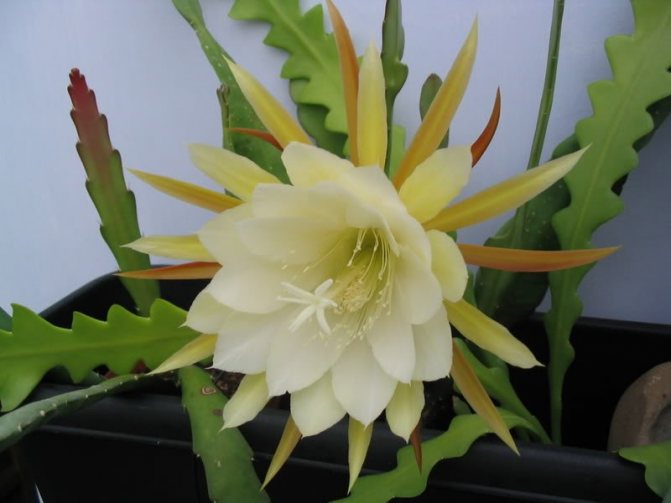

Epiphyllum serrated has serrated stems
Signs and superstitions
All the signs that people associate with cacti fully apply to Epiphyllum, and to believe these signs or not is the business of every person:
- A blooming cactus promises the family an addition, and for the lonely it promises a meeting with the betrothed;
- You cannot give a cactus to a loved one - this promises separation;
- The cactus of unmarried women drives away suitors from them;
- The cactus keeps the house from any troubles.
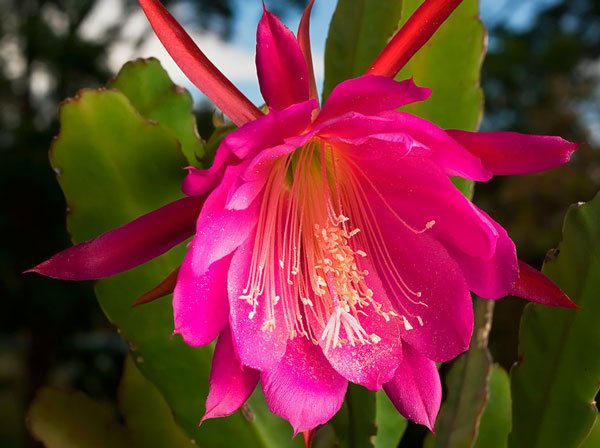

The huge variety of species and varieties of Epiphyllum, its relatively easy nature in terms of maintenance and care, and the splendor of flowering plants attract more and more flower growers to breeding this particular genus of cacti. And for its medicinal properties, it deserves special respect and love.
Growing and growing conditions
Epiphyllums, like most cacti, go through a period of rapid growth and tranquility. In the cold season, a lull sets in for them, all processes are slowed down. In the spring, flowering and shoot growth begins.
Important conditions for the epiphyllum
| Season | Watering | Air temperature, degrees | Fertilizer | Another care |
| Winter | minimum | 10–13 | not | not |
| Spring | abundant | 20–25 | complex formulations for forest cacti | pruning shoots that have bloomed in the past year |
| Summer | plentiful, leaf spraying | 22–25 | nitrogen fertilizers, complex formulations | pruning shoots, including triangular |
| Fall | moderate | 15–20 | complex formulations for problems | transplant after flowering |
Lighting in any season should be diffused.
Tradescantia is distinguished by its unpretentiousness and ease of care. More about this plant:
Healing properties
Epiphyllum has the following healing effects:
- hemostatic;
- wound healing;
- antibacterial;
- anti-inflammatory;
- diuretic;
- tonic.
Epiphyllum effectively treats diseases such as:
- hypotension;
- psoriasis;
- gastrointestinal diseases;
- colds.
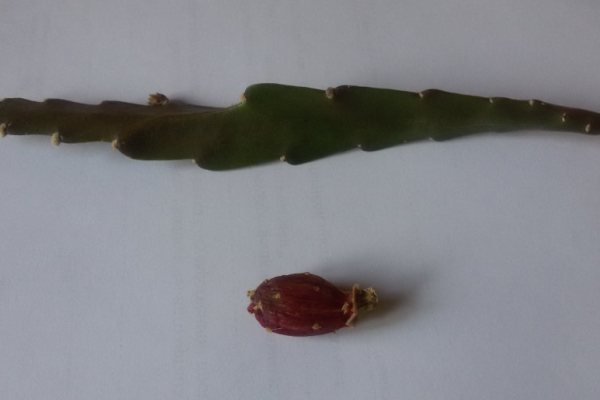

Cactus has healing properties, treats hypotension, psoriasis, colds
Florist reviews
There was an epiphyllum at the window of 3-4 years. Received a minimum of attention. Not blooming. I remember - I will water, I do not remember (in winter, especially) - no. On the window - it was really cold in winter, the glass froze. In the spring, violets needed a place on the windowsill, and I moved the epiphyllum to a bookcase near the window. After 2 weeks, I noticed the buds. The most important thing: there are 2–4 buds on the branches farther from the window, and 9 buds on the branch that touches the glass (that is, VERY much light)! Conclusion: if I hadn't removed the pot from the windowsill, it would have been covered with flowers! And so not all flower buds woke up ... only 19 pieces.
Tanita
I also have epiphyllums. One is pink, the other is white. And pink has been with me for about 20 years. Once I was walking around the city and in one apartment I saw a blooming pink epiphyllum. He was sitting in a saucepan and was completely covered with flowers, the apartment was on the first floor, and I wanted this beauty so much that, stepping over uncertainty and shame, I found this apartment, and begged the hostess to give me a piece of paper. Since then, together with the epiphyllum, I have repeatedly rejuvenated it, and handed out the old one for cuttings, I always remembered how I got it, and tried to share it. It sits in a medium-sized pot with the stems hanging to one side. The pot is on a shelf on the side of the window. He does not bother anyone and no one bothers him. All winter it is light and cold, sometimes I water it, but I never arrange a complete drought, the stems of epiphyllums should not wrinkle over the winter. Already in March, his areoles grow, turn white, pubescent, which means he lays buds. During the budding period, the epiphyllum is very sensitive to rearrangement from place to place and any turns in different directions, if the buds are already outlined, it is better not to touch it at all until the buds become larger, otherwise it will drop them or freeze for a long time, this has been proven over the years. Outside, on the balcony, I take it out with large buds and when it gets warmer. I hang the pot in a pots on the wall, where it blooms and grows all summer, and blooms again in the fall. Fertilizer, in the smallest doses, I apply at every watering. I do not cut it, but only form a bush, so when it grows very long or the old branches begin to wrinkle, then I will cut it. And I live on the 4th floor, and when the epiphyllum blooms, this pink flame can be seen far away. People turn their heads to see what such a beautiful bloom is.
ninaka
Epiphyllums grow in my house, on a shelf, on the side of the window. There is the sun in the morning, in winter time it is close to the window, it is cooler there, and since there are tulle curtains on the windows, with their help, in winter, I regulate the temperature on the window. It's cold, the curtains will be parted so that it is warmer, and if the room is too warm during the day, I move the curtains together, it becomes cooler on the window, everything is for my favorite plants, because I still have hippeastrum, well, about 40, perhaps, not counting the children and other greenery. And in the spring, as it gets warmer outside, I definitely take the epiphyllums to the balcony, in the fresh air the epiphyllums grow good, strong leaves.
Zhelyabina Valentina
Three ways of breeding
Epiphyllum is propagated by seeds, cuttings and layering. Growing from seed is suitable for the most patient growers. Such cacti bloom only after 5 years. The other two methods give faster results.
How to germinate seeds
Stock up on seeds first. Get ripe fruits from your own or someone else's epiphyllum, cut them, remove the seeds, dry them. Then wait for spring and start the sowing campaign:
- Take a container, pour drainage on the bottom, sand on top.
- Moisten the surface, sprinkle the seeds, cover them with sand.
- Cover the container with glass.
- Place in a warm and well-lit place.
- Ventilate for 15 minutes once a day, wipe off condensation. Keep the soil moist.
The young growth of the epiphyllum is prickly and looks like triangular cacti. Growing up, the stems acquire a flat shape and lose thorns.
How to root cuttings ("leaves") in the ground
For the propagation of epiphyllum by cuttings, it is better to take plastic dishes, it keeps moisture longer.
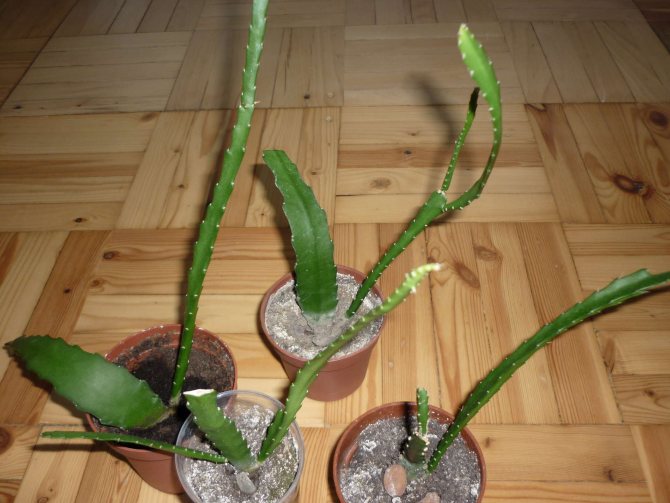

Plant cuttings of phyllocactus in small plastic pots
Engaged in cuttings in April or after flowering, at the end of summer.
Progress:
- A piece of about 12 cm is cut from the stem. Please note that the stem chosen for grafting should not be narrowed at the bottom, such ones take root worse.
- Cut the bottom of the cutting with an angle.
- Rid the workpiece of excess juice by placing it in a container for an hour.
- Dry the cutting for 24 hours.
- Bury the dried cutting into the soil to a depth of 1 cm.
- The stalk does not need to be watered until it takes root: watering can cause rotting. Moisten the soil surface with a spray bottle.
- When the stalk gives a root, it is transplanted into a small pot, 7-8 cm in diameter.
How to get air layers to give roots
Examine your epiphyllum carefully. At a sufficiently high humidity, aerial roots form on the stems of the plant. They will help you get a new flower. Found - take action:
- Bend the stem with roots to the soil and deepen a little.
- After some time, the stem will develop roots. Separate part of the stem with roots and dry slightly.
- Transplant the layer into a new pot ...
- ... And wait for the roots to fill the entire space. Then your cactus will bloom soon.

